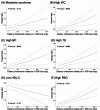Influence of dietary cholesterol on metabolic syndrome risk in middle-aged Korean adults: using the Korean Genome and Epidemiology Study (KoGES)
- PMID: 39334420
- PMCID: PMC11438006
- DOI: 10.1186/s12944-024-02271-1
Influence of dietary cholesterol on metabolic syndrome risk in middle-aged Korean adults: using the Korean Genome and Epidemiology Study (KoGES)
Abstract
Background: The association between dietary cholesterol and metabolic diseases remains controversial. However, the majority of studies focus on egg intake, and there is a limitation in the availability of prospective cohort studies. Our study examined the association between dietary cholesterol and the incidence risk of metabolic syndrome (MetS) in middle aged adults using large prospective cohort study in Republic of Korea.
Methods: The Health Examinees cohort from the Korean Genome and Epidemiology Study was used from baseline to follow-up. Dietary cholesterol intake was assessed by the validated semi-quantitative food frequency questionnaire. Participants were classified as quintile groups according to adjusted dietary cholesterol for total energy intake. MetS was defined as more than 3 of the 5 components of MetS. Hazard ratio (HR) and 95% confidence intervals (CI) for MetS were evaluated by multivariable cox regression analyses.
Results: Of the total 40,578 participants, metabolic syndrome developed in 4,172 (10.28%) individuals during an average follow-up period of approximately 4.76 years. Dietary cholesterol did not exhibit a significant association with the risk of MetS after adjusting for potential confounding factors, but a trend was observed indicating an increased risk with higher intake (p for trend = 0.044). Among the components of MetS, the incidence risk of high waist circumference (HR: 1.164, 95% CI: 1.049-1.290), high blood pressure (HR: 1.188, 95% CI: 1.075-1.313), high serum triglyceride (HR: 1.132, 95% CI: 1.044-1.227) and high fasting blood glucose (HR: 1.217, 95% CI: 1.132-1.308) in the group that consumed the highest dietary cholesterol intake was increased compared with the group that consumed the lowest dietary cholesterol intake. Dose-response relationship suggested a positive linear association between dietary cholesterol intake and the risk of high waist circumference (p-linearity = 0.004), blood pressure (p-linearity = 0.012), and triglycerides (p-linearity = 0.005).
Conclusion: This study suggests a positive association between dietary cholesterol intake and the risk of MetS and its components (abdominal obesity, hypertension, hypertriglyceridemia, and hyperglycemia) in middle-aged Korean adults.
Keywords: Dietary cholesterol; HEXA study; KoGES; Metabolic syndrome.
© 2024. The Author(s).
Conflict of interest statement
The authors declare no competing interests.
Figures

Similar articles
-
Proinflammatory Dietary Intake is Associated with Increased Risk of Metabolic Syndrome and Its Components: Results from the Population-Based Prospective Study.Nutrients. 2020 Apr 24;12(4):1196. doi: 10.3390/nu12041196. Nutrients. 2020. PMID: 32344617 Free PMC article.
-
Dairy product intake is inversely associated with metabolic syndrome in Korean adults: Anseong and Ansan cohort of the Korean Genome and Epidemiology Study.J Korean Med Sci. 2013 Oct;28(10):1482-8. doi: 10.3346/jkms.2013.28.10.1482. Epub 2013 Sep 25. J Korean Med Sci. 2013. PMID: 24133353 Free PMC article.
-
Carbohydrate Intake Levels and the Risk of Metabolic Syndrome in Korean Populations: A Prospective Study.Nutrients. 2024 Jul 26;16(15):2440. doi: 10.3390/nu16152440. Nutrients. 2024. PMID: 39125319 Free PMC article.
-
Does the Combination of Metabolic Syndrome and Low Fat-Free Mass Shorten an Individual's Disability-Free Life? A 12-Year Prospective Cohort Study of the Korean Genome and Epidemiology Study (KoGES).Public Health Nurs. 2025 Mar-Apr;42(2):675-683. doi: 10.1111/phn.13494. Epub 2024 Nov 27. Public Health Nurs. 2025. PMID: 39603811 Review.
-
Trend of Metabolic Syndrome Indicators in Working Korean Women According to Smoking Status and Workplace Size: A Population-Based Retrospective Longitudinal Study.Public Health Nurs. 2025 Mar-Apr;42(2):709-722. doi: 10.1111/phn.13510. Epub 2024 Dec 15. Public Health Nurs. 2025. PMID: 39676030 Free PMC article. Review.
References
-
- Alberti KG, Eckel RH, Grundy SM, Zimmet PZ, Cleeman JI, Donato KA et al. Harmonizing the metabolic syndrome: a joint interim statement of the International Diabetes Federation Task Force on Epidemiology and Prevention; National Heart, Lung, and Blood Institute; American Heart Association; World Heart Federation; International Atherosclerosis Society; and International Association for the Study of Obesity. Circulation. 2009;120(16):1640-5. - PubMed
-
- Huh JH, Kang DR, Kim JY, Koh KK, on behalf of the Taskforce Team of the Metabolic. Syndrome fact sheet of the Korean Society of Cardiometabolic Syndrome. Metabolic syndrome fact sheet 2021: executive report. Cardiometab Syndr J. 2021;1(2):125–34.
-
- Li Y, Pei H, Zhou C, Lou Y. Dietary cholesterol consumption and incidence of type 2 diabetes mellitus: a dose-response meta-analysis of prospective cohort studies. Nutr Metab Cardiovasc Dis. 2023;33(1):2–10. - PubMed
-
- Kwon YJ, Lee HS, Chang HJ, Koh SB, Lee JW. Association of dietary lipid intake with low-density lipoprotein cholesterol levels: analysis of two independent population-based studies. Eur J Nutr. 2020;59(6):2557–67. - PubMed
MeSH terms
Substances
LinkOut - more resources
Full Text Sources
Medical

